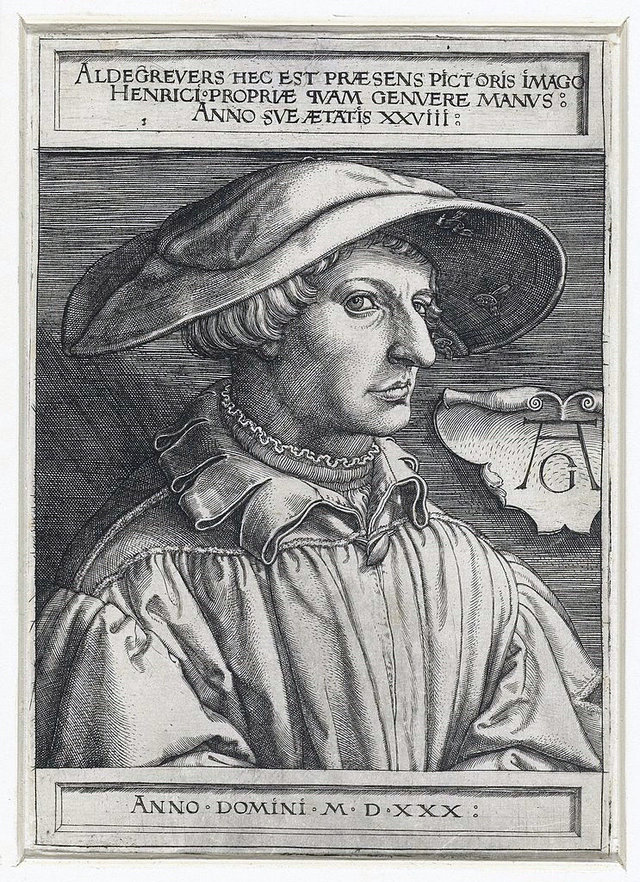Heinrich Aldegrever or Aldegraf (1502–1555, 1558 or 1561) was a German painter and engraver. He was one of the “Little Masters”, the group of German artists making small old master prints in the generation after Albrecht Dürer.
Biography
Painter, printmaker and goldsmith active in a Westphalia milieu. Born in Paderborn. His real name was Trippenmecker, which in Westphalian dialect means a clog-maker. It is not known where Aldegrever was taught. He probably worked in a workshop of one of the Soest goldsmiths. His early works show a strong Westphalian influence. Aldegrever made a journey to the Netherlands, where he became acquainted with works of Joos van Cleve, Barendt van Orley, Lucas van Leyden and Jacob Cornelisz.
Around 1525 he moved to Soest, where a year later he painted the wings and predella of the Mary altar for the church of St. Peter. His signature and symbolic clog show that he was still using his father’s name.
His first engravings appeared in 1527. They were signed with a monogram “AG”, resembling closely that of Albrecht Dürer. In 1531, influenced by surrounding religious fervour, he became a Lutheran. Because of lack of church commissions he devoted most of his time to portrait painting and printmaking. Aldegrever’s some 290 engravings and woodcuts, chiefly from his own designs, are delicate and minute, though somewhat hard in style, and entitle him to a place in the front rank of the so-called “Little Masters”: Barthel Beham, his brother Hans Sebald Beham, and Georg Pencz, with whom he is often compared. Like them, he was also a skilled ornament designer. From the close resemblance of his style to that of Albrecht Dürer he has also sometimes been called the “Albert of Westphalia”.
About a third of his prints were ornamental engravings; they were used as models by artists and craftsmen well into the seventeenth century.
Aldegrever, who actively supported the Reformation, executed portraits of Martin Luther and Philip Melanchthon. Although he chose the Lutheran Church, he had friends among the Anabaptists. He was commissioned by the bishop of Münster in 1535–36 to engrave portraits of Anabaptist leaders Jan van Leyden and Bernhard Knipperdolling, although they were already imprisoned, and only caricatures of them circulated. In the cycle Power of Death, done under visible influence of Hans Holbein, he criticizes the vices of the Catholic Church.
Aldegrever was interested also in folk subjects. In 1538 and 1551 two series of prints depicting marriage dances were made. An important part of his oeuvre are prints on mythological subjects, the Deeds of Hercules being one of the best examples.
Only two paintings are firmly attributed to him: the wings and predella of the Marienaltar (c. 1525-6) in the Wiesenkirche in Soest, and a portrait of Graf Phillip von Waldeck (1837) in Schloss Aroldsen.
Works
1527 Standing Madonna, Seated Madonna, Saint Christopher, Three Ornament Designs for Cross Fillings
1528 Four designs for transverse fillings, Dagger Sheath with Landsknecht, Dagger Sheath with Babylonian Buhlerin, Joseph sells cereal to his brothers, Judith, Simson & Delila, Orpheus & Eurydice, Faith, Intemperance, Strength, Ensign, Half-length portrait of an old man
1529 Adam, Eve, Medea & Jason, Mars, Hercules & Antaeus, The Lovers, Admonition to Death, The Landsknecht, Three Crossfill Designs, Dagger Sheath with David, Dagger Sheath with John
1530 Loth and his daughters, The abduction, Mucius Scaevola, monk and nun, self-portrait at 28 years old
1532 Joseph tells his dreams, Joseph escapes from Potiphar’s wife, Potiphar’s wife sues Joseph, Joseph escapes from temptation, Jacob reflects on Joseph’s dreams, Bathsheba, Marcus Curcius, fight frieze with Hector, dagger’s sheath with husband and wife, dagger’s scabbard with naked husband and wife, dagger’s sheath with soldier and naked woman
1533 Diana, Mercury, Jupiter, Venus, Saturn
1535 Children frieze, bear frieze, dagger sheath with bust of a helmeted man, dagger sheath with bust of a queen
1536 Design of three agraffes, dagger design with a naked couple, portrait of Jans van Leyden, portrait of Bernhard Knipperdolling
Lovespeaker in love in 1537, self-portrait at the age of 35, design for a belt buckle, design for a sword-tail, design for a dagger
1538 Battle frieze with Hannibal & Scipio, Judgment of Paris, Little wedding dancers, Great wedding dancers, portrait of Albert van der Helle
1539 Four Evangelists, Tarquinius & Lucretia, design for two spoons, design for a dagger with David & Goliath
1540 Adam & Eve, Amnos & Thamar, The Ensign, Portrait of Duke Wilhelm, Portrait of Jülich-Cleve-Berg, Portrait of Martin Luther, Portrait of Melanchthon
1541 Dance of Death
1549 allegory series
1550 Heraklesfolge, The victorious Savior
1551 Adam & Eve
1552 Venus & Cupid, Little Wedding Dancers, Episode of Virtues & Vice
1553 Annunciation of Mary, Nativity, Christ on the cross, Madonna with death’s crown, Madonna sitting, Sophonisbe, Tarquinius & Lucretia, Titus Manilius, The stern father, Thisbe killing herself, The Night
1554 Parable of the Good Samaritan, parable of the rich man and Lazarus
1555 History of Susanna, Judgment of Solomon, History of Loth, Nemesis
Reception
In 1989, Kord Winter created the Aldegrever fountain in Soest for a motif The Great Wedding Dancers.
Auctions
From the multi-day auction of the v. By the book dealer and auctioneer IL Schmidmer (1779-1831) 1825 carried out in Nuremberg. Derschauischen Kunstkabinett zu Nürnberg ( Hans Albrecht von Derschau † 1824) are further works proven.
Source from Wikipedia
